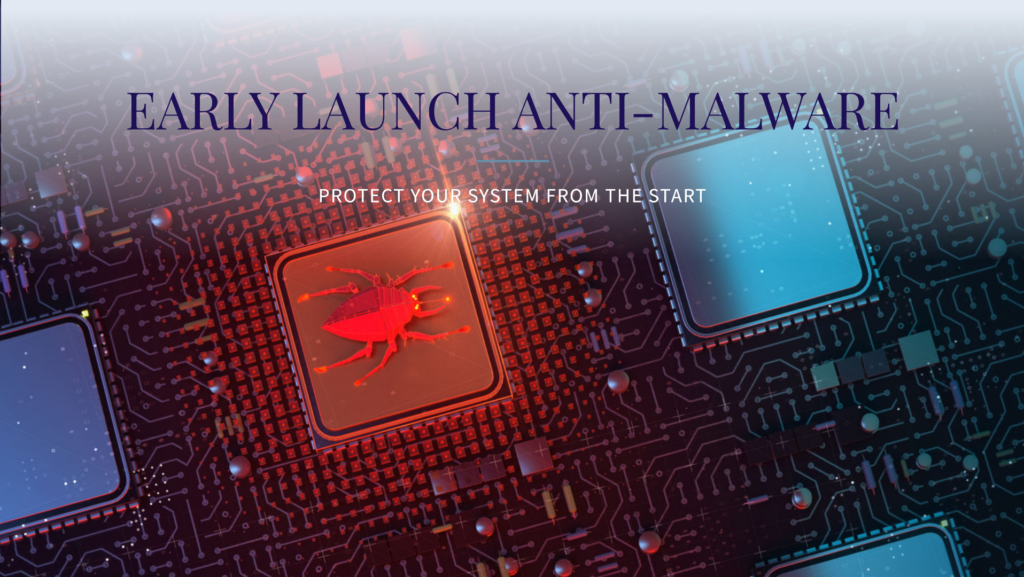Welcome to our Technology Moment, where we delve into the latest advancements and insights shaping the digital landscape. In this inaugural edition, we’re shining a spotlight on the urgent need for robust anti-malware solutions in today’s interconnected world. As we prepare for the early launch of our blog, join us as we explore the evolving threats posed by malware and the innovative technologies designed to combat them. Stay tuned for expert analysis, industry trends, and practical tips to safeguard your digital assets. It’s time to fortify our defenses and embrace a safer digital future together.
Firstly, we define what early launch anti-malware is. This involves explaining its fundamental concept and how it differs from traditional anti-malware solutions. Early launch anti-malware operates by intercepting and neutralizing potential malware threats at the earliest stage of the system boot process, before any malicious code can execute.
Next, we highlight the significance of early launch anti-malware in today’s digital landscape. We discuss the increasing sophistication of malware threats and the growing need for proactive security measures. With cyberattacks becoming more prevalent and sophisticated, traditional security approaches are often insufficient in providing adequate protection. Early launch anti-malware fills this gap by offering an additional layer of defense against evolving malware threats.
Furthermore, we may touch upon the broader implications of malware attacks, such as financial losses, data breaches, and reputational damage for individuals and organizations. By emphasizing the potential consequences of malware infections, we underscore the importance of early launch anti-malware as a proactive defense mechanism.
Table of Contents
Understanding Early Launch Anti Malware
It encompasses a broad range of malicious programs, each with its own specific purpose and method of operation. Here are some common types of malware:
- Viruses: Viruses are programs that attach themselves to legitimate files or programs and replicate themselves to spread to other files and computers. They can cause various types of damage, from corrupting files to disrupting system operations.
- Trojans: Named after the mythical Trojan horse, trojans disguise themselves as legitimate software to trick users into downloading and installing them. Once installed, they can perform a variety of harmful actions, such as stealing sensitive information or providing remote access to the attacker.
- Worms: Worms are standalone malware programs that replicate themselves across networks without requiring user interaction. They can spread rapidly and cause widespread damage by exploiting vulnerabilities in network protocols or software.
- Ransomware: Ransomware encrypts files or locks users out of their systems and demands a ransom payment in exchange for restoring access. It has become increasingly prevalent in recent years and can have devastating consequences for individuals and organizations alike.
- Spyware: Spyware silently monitors and collects information about a user’s activities without their knowledge or consent. It can capture keystrokes, track browsing habits, and steal sensitive information such as login credentials and financial data.
The Need for Early Detection
Malware, including viruses, worms, trojans, ransomware, and spyware, pose significant threats to individuals, businesses, and governments worldwide. These malicious programs are designed to infiltrate systems, steal sensitive information, disrupt operations, and sometimes even hold data for ransom.
The risks associated with malware attacks are multifaceted and can have devastating consequences:
- Data Breaches: Malware often aims to compromise sensitive data such as personal information, financial records, and intellectual property. In the event of a successful breach, the confidentiality, integrity, and availability of this data are compromised, leading to financial loss, legal ramifications, and reputational damage.
- Financial Loss: Malware attacks can result in financial losses for individuals and organizations through various means, including theft of funds, extortion through ransomware, and costs associated with remediation and recovery efforts.
- Operational Disruption: Malware can disrupt essential business operations by disabling critical systems, disrupting network connectivity, or causing system crashes.
- Reputation Damage: Public trust is paramount for businesses and organizations. A malware attack can tarnish an entity’s reputation by exposing vulnerabilities, demonstrating inadequate security measures, and causing disruptions that inconvenience customers or stakeholders.
- Regulatory Non-Compliance: Many industries are subject to regulatory requirements governing data protection and privacy. A malware attack that results in a data breach may lead to regulatory fines, legal penalties, and loss of customer trust, especially if it’s determined that inadequate security measures contributed to the incident.
Given the severity of these risks, early detection of malware is imperative. By identifying and mitigating threats in their nascent stages, organizations can minimize the impact of malware attacks and prevent potential damage before it escalates. Early detection enables proactive responses such as isolating infected systems, deploying patches and updates, and implementing additional security measures to prevent further infiltration.
Moreover, early detection enhances incident response capabilities, allowing organizations to contain and remediate threats swiftly, thereby reducing downtime, financial losses, and reputational damage. Implementing robust detection mechanisms, such as intrusion detection systems (IDS), endpoint protection platforms (EPP), and security information and event management (SIEM) solutions, is essential for proactive threat detection and response.
What is Early Launch Anti-Malware?
Early Launch Anti-Malware is a proactive security measure designed to prevent malware from executing during the early stages of a computer’s boot process. It is a specialized form of anti-malware software that operates at a fundamental level within the operating system to intercept and neutralize potential threats before they can cause harm.

At its core, Early Launch Anti-Malware works by monitoring the system’s boot process and analyzing critical system components for signs of malicious activity. It aims to identify and block malware before it has a chance to fully infiltrate the system and compromise sensitive data or disrupt system operations.
One of the key features of Early Launch Anti-Malware is its ability to operate before other third-party applications and drivers are loaded into memory during the boot sequence. This allows it to establish a secure environment early on, reducing the likelihood of malware bypassing traditional security measures that may be activated later in the boot process.
Early Launch Anti-Malware typically employs a combination of signature-based detection, behavior analysis, and heuristic scanning techniques to identify and neutralize threats. It may also leverage cloud-based threat intelligence and machine learning algorithms to enhance its detection capabilities and adapt to evolving malware threats.
By intercepting and blocking malware at the earliest stages of system startup, Early Launch Anti-Malware helps to minimize the risk of infection and ensure the integrity and security of the operating system. It serves as an essential layer of defense in a comprehensive security strategy, complementing other security measures such as antivirus software, firewalls, and intrusion detection systems.
Advantages of Early Launch Anti-Malware
Early launch anti-malware offers several key advantages in bolstering cybersecurity defenses:
- Real-time Protection: One of the primary benefits of early launch anti-malware is its ability to provide real-time protection against malware threats. By intercepting and analyzing potential threats before they have a chance to execute, early launch anti-malware can prevent malicious software from infiltrating the system and causing harm. This proactive approach ensures that users are safeguarded against the latest and most sophisticated forms of malware.
- Prevention of Malware Execution: Unlike traditional antivirus solutions that primarily focus on detecting and removing malware after it has already infected a system, early launch anti-malware takes a preemptive approach by intercepting threats during the boot process or before they are allowed to execute. By blocking malware at the earliest stages of infection, this technology helps prevent the exploitation of system vulnerabilities and mitigates the risk of data breaches, system compromise, and other security incidents.
- Minimization of Damage: By stopping malware in its tracks before it can fully infiltrate the system, early launch anti-malware helps minimize the potential damage and impact of cyber attacks. This proactive defense mechanism not only protects sensitive data and resources but also reduces the need for costly remediation efforts and downtime associated with malware infections. By thwarting attacks before they can escalate, early launch anti-malware helps organizations maintain continuity of operations and uphold their reputation for robust cybersecurity practices.
Implementation of Early Launch Anti-Malware
When it comes to implementing early launch anti-malware, there are several key steps and considerations to ensure its effectiveness in protecting systems from malicious attacks. Let’s delve into each aspect:
- Available Solutions and Software: There are various software solutions available in the market designed to provide early launch anti-malware protection. These solutions may come in the form of standalone antivirus programs or integrated security suites offered by reputable cybersecurity companies. It’s essential to research and choose a solution that best fits the specific needs and requirements of your system or organization.
- Integration with Existing Security Measures: Early launch anti-malware should seamlessly integrate with existing security measures already in place within your system or organization. This integration ensures comprehensive protection against a wide range of malware threats while minimizing any potential conflicts or compatibility issues. Compatibility with other security software, firewalls, and intrusion detection systems should be carefully assessed during the implementation process.
- Configuration and Optimization: Once the early launch anti-malware solution is installed, it’s crucial to configure and optimize its settings for optimal protection. This includes customizing scan schedules, setting up real-time monitoring features, and enabling automatic updates to ensure the software remains up-to-date with the latest threat definitions. Additionally, specific settings related to malware detection sensitivity and quarantine actions should be adjusted based on the unique security needs of the system or organization.
- Training and Awareness: Effective implementation of early launch anti-malware also involves educating users and stakeholders about the importance of malware prevention and the role of the installed security measures. Training sessions and awareness campaigns can help users recognize potential threats, understand safe browsing practices, and know how to respond in the event of a security incident. This proactive approach empowers users to become active participants in maintaining a secure computing environment.
- Monitoring and Maintenance: Implementing early launch anti-malware is not a one-time task but rather an ongoing process that requires regular monitoring and maintenance. System administrators should routinely check for updates, review security logs for any suspicious activity, and conduct periodic security assessments to identify and address potential vulnerabilities. By staying vigilant and proactive, organizations can effectively mitigate the risk of malware attacks and ensure the continued effectiveness of their security measures.
Best Practices for Utilizing Early Launch Anti-Malware
Early launch anti-malware solutions are crucial for safeguarding systems against various cyber threats. However, simply installing such software is not enough; it requires proper configuration and maintenance to ensure optimal protection. Here are some essential best practices for effectively utilizing early launch anti-malware:
- Regular Updates and Maintenance: One of the fundamental aspects of maintaining the efficacy of early launch anti-malware is to ensure that it is regularly updated. Cyber threats evolve rapidly, and malware developers constantly devise new tactics to bypass security measures. Therefore, keeping the anti-malware software up-to-date with the latest virus definitions and security patches is vital to defend against emerging threats.
- Configuring Settings for Optimal Protection: Most early launch anti-malware solutions offer various configuration options to customize the level of protection according to specific needs. It’s essential to review and adjust these settings based on the system’s requirements and the organization’s security policies. This may include specifying which files or processes to monitor, setting up scheduled scans, and configuring quarantine or remediation actions for detected threats.
- Integration with Existing Security Measures: Early launch anti-malware should complement other security measures already in place within the organization’s IT infrastructure. Integration with endpoint protection platforms, firewalls, intrusion detection systems, and security information and event management (SIEM) solutions enhances overall security posture and provides comprehensive threat visibility and response capabilities.
- User Training and Awareness: No security solution can fully protect against human error or social engineering tactics. Therefore, educating users about the importance of cybersecurity hygiene and best practices is crucial. Training programs should cover topics such as recognizing phishing emails, avoiding suspicious websites, and exercising caution when downloading files or clicking on links.
- Monitoring and Incident Response: Implementing early launch anti-malware is just one aspect of a robust cybersecurity strategy. Organizations must also establish mechanisms for continuous monitoring of system activities and network traffic to detect potential security incidents promptly. Additionally, having a well-defined incident response plan ensures that any security breaches or malware infections are promptly identified, contained, and remediated to minimize their impact.
Case Studies
This section will provide real-world examples of successful implementation of early launch anti-malware solutions. It aims to illustrate the practical benefits and effectiveness of such measures in enhancing overall cybersecurity.
Examples of Successful Implementation:
Here, we’ll delve into specific cases where organizations or individuals have implemented early launch anti-malware solutions with positive outcomes. We’ll explore instances where these solutions successfully detected and thwarted malware attacks, preventing potential data breaches or system compromises. These case studies will showcase the diverse applications of early launch anti-malware across various industries and settings, ranging from small businesses to large enterprises.
Impact on Security Measures:
This subsection will examine the broader impact of implementing early launch anti-malware on overall security measures within an organization. We’ll analyze how these solutions contribute to a more robust security posture, reducing the likelihood of successful cyberattacks and enhancing the resilience of IT infrastructure. By highlighting the tangible benefits experienced by organizations that have adopted early launch anti-malware, we aim to underscore its importance as a proactive defense mechanism against evolving cyber threats.
Challenges and Limitations
When implementing early launch anti-malware solutions, there are several challenges and limitations that users may encounter. It’s crucial to be aware of these potential obstacles to ensure effective security measures.
- Compatibility Issues:
- One significant challenge is compatibility with existing software and operating systems. Early launch anti-malware solutions may not always seamlessly integrate with all systems, leading to compatibility issues that can hinder their effectiveness.
- Resource Consumption:
- Another limitation is the consumption of system resources. Some early launch anti-malware solutions may be resource-intensive, causing slowdowns or performance issues on the device where they are installed. This can be particularly problematic for devices with limited resources or older hardware.
- Effectiveness Against Advanced Threats:
- While early launch anti-malware solutions are effective against many common malware threats, they may struggle to detect and mitigate advanced or sophisticated threats. Cybercriminals are constantly evolving their tactics, making it challenging for traditional anti-malware solutions to keep up with the rapidly changing threat landscape.
Future Trends and Innovations
The landscape of cybersecurity is ever-evolving, and staying ahead of emerging threats requires constant innovation. In this section, we’ll explore the future trends and innovations expected in early launch anti-malware technology.
1. Evolution of Early Launch Anti-Malware:
As cyber threats become more sophisticated, the technology behind early launch anti-malware will continue to evolve. Developers are constantly refining algorithms and detection methods to keep pace with new and emerging malware strains. This evolution may involve deeper integration with operating systems, improved heuristic analysis, and enhanced behavioral detection techniques.
2. Integration with AI and Machine Learning:
One of the most significant trends in cybersecurity is the integration of artificial intelligence (AI) and machine learning (ML) into anti-malware solutions. These technologies enable systems to learn from past attacks and adapt their defenses in real-time. Early launch anti-malware solutions that leverage AI and ML algorithms can quickly identify and respond to new threats, even those that haven’t been previously encountered.
3. Enhanced Threat Intelligence:
Future early launch anti-malware solutions will likely incorporate advanced threat intelligence capabilities. This includes access to large-scale threat databases, automated threat hunting, and predictive analytics. By leveraging threat intelligence, these solutions can proactively identify potential threats before they manifest into full-blown attacks, thereby minimizing the impact on users and systems.
4. Cloud-Based Protection:
With the proliferation of cloud computing, the future of early launch anti-malware may involve cloud-based protection mechanisms. By offloading certain detection and analysis tasks to cloud servers, these solutions can conserve local resources while benefiting from the scalability and flexibility of cloud infrastructure. Additionally, cloud-based solutions can provide real-time updates and threat intelligence feeds to ensure users are protected against the latest threats.
5. Collaboration and Information Sharing:
In the future, we can expect increased collaboration and information sharing among cybersecurity vendors, researchers, and organizations. This collaborative approach allows for faster threat detection and response by pooling resources and sharing insights into emerging threats. Early launch anti-malware solutions that participate in these collaborative networks can leverage collective intelligence to improve their detection capabilities and better protect users against evolving threats.
Tips for Choosing the Right Early Launch Anti-Malware Solution
Selecting the appropriate early launch anti-malware solution is crucial for ensuring robust protection against evolving cyber threats. Here are some essential tips to consider when making your choice:

- Compatibility with Operating Systems: Ensure that the anti-malware solution is compatible with the operating systems used within your environment. Whether you’re running Windows, macOS, Linux, or other platforms, compatibility ensures seamless integration and effective protection.
- User-Friendly Interface: Complex configurations and convoluted settings can hinder the deployment and management of the software. A streamlined interface simplifies navigation and facilitates efficient management of security protocols.
- Scalability: Choose a solution that can scale according to the needs of your organization. As your business grows, so does the potential threat landscape. Scalable anti-malware solutions can adapt to changing environments and accommodate increased workloads without compromising performance.
- Detection and Prevention Capabilities: Look for features that offer robust detection and prevention capabilities. Advanced threat detection mechanisms, heuristic analysis, and behavior monitoring can enhance the efficacy of early launch anti-malware solutions in identifying and neutralizing malicious activities.
- Performance Impact: Assess the performance impact of the anti-malware solution on your system resources. While it’s essential to prioritize security, excessive resource consumption can impede system performance and productivity. Choose a solution that strikes a balance between security and performance optimization.
- Customer Support and Updates: Evaluate the quality of customer support and the frequency of software updates provided by the vendor. Responsive customer support ensures timely assistance in troubleshooting issues and addressing concerns. Regular updates are crucial for staying ahead of emerging threats and maintaining the effectiveness of the anti-malware solution.
- Integration with Existing Security Infrastructure: Ensure seamless integration with your existing security infrastructure. Compatibility with other security tools and protocols streamlines operations and facilitates centralized management of security policies. Interoperability enhances the overall effectiveness of your cybersecurity posture.
- Reputation and Reviews: Research the reputation of the anti-malware solution provider and review feedback from other users. Positive reviews and endorsements from reputable sources are indicators of reliability and effectiveness. Conversely, negative reviews or a lack of credibility should raise red flags and prompt further investigation.
Educational Resources
In the realm of cybersecurity, staying informed and continuously learning about new threats, technologies, and best practices is crucial. The “Educational Resources” section aims to provide readers with avenues for expanding their knowledge and skills in the field of early launch anti-malware.
- Online Courses and Tutorials:
- There are numerous online platforms offering courses and tutorials on cybersecurity topics, including early launch anti-malware. Websites like Coursera, Udemy, and Cybrary provide a wide range of courses catering to different skill levels, from beginners to advanced users. These courses cover various aspects of malware detection and prevention, including the role of early launch anti-malware in securing systems.
- Blogs and Forums for Discussion:
- Blogs and forums are excellent resources for staying updated on the latest trends, news, and insights in the cybersecurity community. Readers can find blogs maintained by security experts, where they share their experiences, research findings, and recommendations regarding early launch anti-malware solutions. Additionally, participating in online forums such as Reddit’s cybersecurity subreddit or specialized forums like MalwareTips allows individuals to engage in discussions, seek advice, and learn from the experiences of others in the field.
Conclusion
In the conclusion section, we aim to tie together the key points discussed throughout the article and reinforce the importance of early launch anti-malware in today’s cybersecurity landscape.
Firstly, we’ll recap the significance of early launch anti-malware in combating the ever-evolving threat of malware. By providing a proactive defense mechanism, early launch anti-malware plays a crucial role in preventing malicious software from infiltrating systems and causing harm.
We’ll emphasize that while traditional antivirus solutions are essential, they may not always be sufficient in detecting and preventing sophisticated malware attacks. Early launch anti-malware adds an extra layer of protection by intercepting malicious code before it has a chance to execute, thereby safeguarding sensitive data and preserving system integrity.
Additionally, we’ll reiterate the importance of staying vigilant and proactive in maintaining cybersecurity measures. Implementing early launch anti-malware is just one aspect of a comprehensive security strategy. Regular updates, patches, and employee training are equally essential in mitigating the risks posed by malware and other cybersecurity threats.
Lastly, we’ll issue a call to action, urging readers to prioritize cybersecurity in their personal and professional lives. Whether you’re an individual user or responsible for safeguarding an entire organization’s network, investing in early launch anti-malware and other cybersecurity measures is essential in today’s digital age.
FAQs – Frequently Asked Questions
What is early launch anti-malware?
Early launch anti-malware is a proactive security measure designed to prevent malware from executing during the early stages of a computer’s boot process.
How does early launch anti-malware work?
Early launch anti-malware operates by intercepting and neutralizing potential malware threats at the earliest stage of the system boot process, before any malicious code can execute.
Why is early launch anti-malware important in today’s digital landscape?
Early launch anti-malware is crucial due to the increasing sophistication of malware threats and the growing need for proactive security measures to combat them.
What are the advantages of early launch anti-malware?
Early launch anti-malware offers advantages such as real-time protection, prevention of malware execution, and minimization of damage caused by cyber attacks.
How can organizations implement early launch anti-malware effectively?
Organizations can implement early launch anti-malware effectively by selecting compatible solutions, integrating with existing security measures, configuring settings, providing user training, and monitoring and maintaining the software regularly.














I appreciate the early launch of this anti-malware solution! It’s crucial to have robust protection against cyber threats, especially with how rapidly they evolve. Looking forward to seeing how it performs in real-world scenarios!
Great initiative on launching this anti-malware tool early! It’s a timely response to the increasing cyber threats we face today. I hope the user interface is intuitive and that it offers comprehensive protection without compromising system performance.
Kudos on getting this anti-malware product out ahead of schedule! Data protection is more important than ever, and having an early option can really help individuals and businesses safeguard their information. Would love to see more details on its detection capabilities!
Excited about the early launch of your anti-malware software! It’s essential for users to have access to reliable tools that can combat cyber threats effectively. Please keep us updated on any future enhancements or features you plan to introduce.
This early launch is a smart move in today’s digital landscape! Cyber threats are constantly evolving, and having an effective anti-malware solution available sooner rather than later can make a significant difference in protecting sensitive data.